Micro-worlds on the World Wide Web: Dynamical Learning Environments; Second Order Courseware & Applets
by Rik Min, Faculty of Educational Science and Technology, University of Twente.
First published on internet in 1998; later published in: Int. J. of Continuing Engineering, Education and Long-life Learning, vol.9, no.2/3/4, p.302-314, 1999, ISSN 0957-4344. (Updated: okt. 2000)
Introduction
A student today no longer spends his time in a lonely little attic room, a noisy lecture room or the deadly silence in the huge reading room of a university library. These components of his environment still exist but their functionality has changed. In principal all students at the campus of the University of Twente (UT) have an excellent connection with the electronic highway. The World Wide Web is extremely popular, both among lecturers and students. It fills the almost natural need of young people to want to travel all over the world and to try and understand it. All this at minimum cost please. For many courses, e-mailing with the lecturer is a matter of course. So is publishing educational material on the WEB.
Working, doing and learning environments
The lecture room is no longer the only place where information transfer takes place. In my faculty now adays we have an very modern 'interactive classroom' and a lot of web-site-based courses for distance learning groups specially for locations outside the campus; also e-mailing and computer conferencing systems (CSCW) (FirstClass) is used in some courses to communicate with the lecturer or for a certain interaction between student and lecturer. If students are elsewhere, for instance in the scope of 'internationalization', they can still attend lessons and feel connected with the mother faculty. And as for the university library: the World Wide Web sometimes has in certain disciplines a larger amount of interesting topical reading and study matter than the average faculty library could ever hope to be able to purchase.
Reading rooms will increasingly be transformed into rooms with ordinary WEB browsers or cheap network computers (NC's). Lecture notes, books and sheets are more and more consulted through a PC or NC and printed if necessary. In the latter case we are dealing with a form of 'printing on demand'. Universities and Colleges of Higher Vocational Education are thus able to provide up-to-date information and instruction materials while keeping the cost of printing to a minimum. Lecturers like to put all sorts of information on the WEB. All parties involved in education benefit from it. This means that every actor on the work floor is 100 % motivated to use it. An ideal situation for innovation.
Studying in digital learning environments and organising higher education for the 'knowledge society' is about computer supported education in general. In particular it is about learning environments such as computer-based simulations in the form of inter- active 'dynamic graphics' on the WEB. Meanwhile, we have gathered some experience in a number of courses with tele-learning situations at our faculty of Educational Science and Technology (TO). During the past academic year we have conducted a pilot study into the possibilities and 'performance' (i.e. 'strength' or 'power') of HTML and Java. In particular for on-line learning environments for simulation and problem solving in front of a computer monitor. A number of different interactive on-line simulations have been developed and a number of different on-line tests have been created. The pilot study also yielded a method and system for the design development and implementation of simulations on the WEB (Min, 1997). Students at our university now learn - in a practical - how to make complete learning environments with it. Our experiences and conclusions will here be discussed as well as the impact of these methods and techniques on education elsewhere.
Learning environments
Computer-based simulations have many applications in higher education. There are many different computer-based simulations: patient-simulations, model-driven simulations, animations and simulations in which modelling comes first. The simulations we will deal with here, are mostly based on more or less complex mathematical models. This type of simulation can be used as a learning environment to acquire insight into certain dynamic phenomena which are impossible or very hard to demonstrate in any other way in a classroom or working environment, let alone study them. They are open learning environments which supply loose instructions and casuistry as a rule in order to coach the learner. This is not a good learning environment without coaching and clear assignments. (Min, 1995). Such interactive learning environments can be used on PC's in all types of education: in company trainings or in extramural learning situations, such as Open Universities or simply at home on CD.ROM or CD-i. Of late, these learning environments can also be obtained or used from the electronic highway: the world wide web.
The WEB thus gives the electronic learning environment industry and Computer Based Learning (named by terms as CBT, CAI, CAL or multimedia) a new opportunity. Interactive multimedia now have entered its second - and decisive - stage.
Stand alone multi media products on CD.ROM were (are) characteristic for what we call the first stage in the use of multimedia in education. This stage was characterised by disorder and endless discussions on platforms (stage 1). The WEB is the beginning of a new stage (stage 2); a stage in which electronic learning environments will have to try and obtain a firm footing at schools and on the home market. Multimedia and everything connected with it is just being given a second chance and, if all is well, it will enter its prime. Multimedia will get a more general form, however, and it should be given a much wider scope. For working-environments, doing-environments and learning-environments merge on the electronic highway. Working on-line will be alternated with a suitable off-line way of working and learning. That is where developers and computer based learning should make the most of their chances. The concept of multimedia should be interpreted freely, which is what the market will do. And time will tell whether working and doing will eventually lead to learning.
Instruction environments
Proper coaching and the availability of adequate instruction materials will be of overriding importance for the frequent use of learning environments. Many software designers have failed in this respect (no offence meant to the good ones). Learning environments, and simulations in particular, can only be justified as a learning environment when provided with proper instructions adapted to a lesson and with relevant and topical assignments. Assignments and coaching ,materials should be up-to-date and easy to adapt for an individual teacher or school. An important aspect of learning environments is that teachers like to be able to add something 'useful' or at any rate, they want to be able to adapt something to the materials in question. It should be possible to make suitable assignments or existing instruction materials should be easily adapted ('re-engineering'). All materials should be embedded in(to) the whole of the electronic learning environment. For learning environments with simulations the interactive simulator should be designed in such a way that nobody has to change a lot. That software part is standard supplied by a learning environment designer or a special educational publisher. The instructions, assignments and coaching materials on the other hand should be supplied with more flexibility. In that aspect the teacher should be able to distinguish himself. He must be able to gear his teaching materials and the accompanying materials to the needs of the target group.
The popularity of the WEB
The WEB is firstly a medium with which you can do things yourself. A teacher can provide tailored instructions if he wants to for everybody. By means of the WEB, he can add something of himself to something that already exists (from somebody else). In structure, the WEB is a very democratic medium; comparable to the old duplicator and today's photocopier. Teachers like this type of simple equipment. Anybody can put something on the WEB these days or have something adapted. Learning environments are given the best possible context because a teacher or school can develop his/its own instruction materials or they can adapt existing materials. When software is supplied ready-made, the teacher or school gets less chance to adapt someone else's learning environment than with software on the WEB. Because one can insert one's own WEB-pages into the whole of all other teaching materials (pages and applets). The right balance between an open environment and a bit of coaching can now also be determined and adjusted by the teacher himself. The link that used to be missing (in stage 1) is now in the hands of the teacher. Through this medium the teacher is now able to provide that missing link himself.
Interactive multimedia stands a much better chance of success (in stage 2) if the WEB is used as learning environment rather than a number of isolated PC's with or without CD.ROM drives. The slowness of internet proves to be less of an impediment than expected. The net's poor performance so far can be circumvented or improved upon in various ways.
The management of schools must realise that the WEB can contribute in many ways and in many fields to the 'studeerbaarheid' (studyability?). Keywords for the management are standardisation, actualization and a flexible optimization of modern teaching materials. Keywords for developers are platform independence and Java.
Java
The advent of Java the programming language and other WEB techniques that are available to all provide the designers of learning environments with unlimited possibilities. With the help of Java software designers can make loose components for teachers ('building stones') for example bare computer-based simulations. It does not matter on what platform something is developed: the applications ('applets') are platform independent. Building stones made in Java can be included in any WEB page. These bare building stones are called 'applets'. Applets are found on a WEB page and they are usually interactive, visual and dynamic. That particular form is for education the one with the most possibilities. These days an increasing amount of valuable applications in applet form is appearing. SUN, IBM and Apple as well as MicroSoft are working night and day in order to write their standard programs in Java in order not to lose the battle for the WEB. Even WP wants to produce its word processing program as Java-applets on the WEB.
Applets are powerful in spite of the fact that this type of software has to be interpreted by a browser. The 'performance' of a simulation program as applet -embedded in all kinds of instruction materials of a WEB-site- is fairly good in general. It depends on the dimensioning and the way in which an applet has been embedded into the whole. A publisher or designer can make an applet and a basis instruction with examples whereas a teacher can decide to do something completely different.
During the past 6 months we have looked into the possibilities as researchers how our ideas about form and set up of the learning environment (from stage 1) could be applied in stage 2. Our investigations have so far resulted in a working prototype for a simulation system that can easily make model-driven simulations for the WEB. The products which this system cab provide -in the form of applets- are platform independent and consequently can be used on any computer. See figure 1.
Education
Due to its trainings in the field of learning environments technology, the faculty of Educational Science and Technology has with certain courses (in the field of programming drills and practice, games, simulations etc.) for many years given Pascal-oriented practicals. Students learned how to program simple multimedia products in higher programming languages -besides designing and developing with authoring tools. Since three years this is no longer Pascal but these exercises are now based on Prolog, HyperTalk and HTML. Nowadays first year students also learn how to handle java-script and during their final year how to handle java objects in the course 'Computer Simulation as a Learning Tool'. We are now considering to include a course of java-programming in the compulsory part of the curriculum of our four-year-study. The pilot-project described here is also intended as a preparation for this possible change in the curriculum.
In this pilot-project, our team wanted to kill two birds with one stone: firstly they wanted to get some idea of the possibilities of Java and java-applets and secondly they wanted to develop a system that could be used in the said optional course in the fourth year: 'Computer simulation as a Learning Tool'.
Research
Due to all the demands which modern education makes on teachers, a valuable learning environment for simulations should have a clear structure and be designed, realised and distributed in a specific way. When a working environment functions in the best possible way and enables an efficient way of working this should be based on a well-approved philosophy. However, Internet does have its limitations. The WEB has a very definite and dominant interface concept. This results in certain limitations in respect on stand alone software. It is true that this is a disadvantage but (off line) stand alone software has it too due to its immense number of freedom degrees. Design-oriented research is required to see if these limitations can yet lead to the type of learning environments that we want. We then get learning environments -on the WEB- based on recent insights of parallelism for learning environments in conformity with the 'parallel instruction theory (the 'pi-theory') (Min, 1992; Min, 1994). What those insights really say is that pupils should have all kinds of information within their field of vision and within their (physical) reach. If not, then they do not have the best possible learning environment and then there will not be optimal study results or school success.
Within this pilot-project we have looked at the specific possibilities and advantages of applets and whether our ideas on parallelism and parallel instruction could be applied within the WEB.
We first tried to establish how model-driven animation on the WEB could be realised with Java and what the performance of this type of animation would be. For instance by trying to move a bitmapped object against any type of background. This being an important technique for simulations. The performance was not bad at all. The next experiment was aimed to find out if we could make a 'growing graphic' for monitoring variables; also essential in simulation. We did not want just any 'graphic diagram making program', for there are already hundreds of those. But a slowly growing diagram such as one sees in hospitals beside a patient's bed, registering the ECG and blood pressure. We wanted to be able to read the actual value of variables and the actual time in numbers. All this is of the greatest importance in a simulation environment.
Results
In the scope of the 'first flow' of funds (1e geldstroom fondsen) design-oriented research our team finally developed a number of simulation programs in Java: interactive applets for model-driven simulations with the character of 'dynamic graphics' integrated in a 'content-rich' WEB-site. We used the Java Developers Kit Version 1.0.2 (JDK) for the Macintosh computer, developed by Sun Microsystems Inc. (1992-96) and MicroSoft J++ on Wintel-computers. Netscape 3.0 (or newer) was used to run the applets.
Models
From the beginning we used realistic and tried simulation models so that we knew exactly what we were doing. But as yet we used only simple examples. We used mathematical models with which we had already gained a lot of research and teaching experience. We kept the larger simulation models for a later phase in our research. The idea is to involve our own students and to have them find out how the larger models can be implemented.
Earlier we had formulated as our objective that the development of applets should result in a universal simulation system with which others could also develop simulations in Java. The product was promoted on the WEB in the usual fashion i.e. by recommending products in media on the WEB and testing them. Anybody can work with it now and give us feedback.
Programs
The applets realised by us have been put on the WEB as open learning environments as well as in the form of a 'case'. A pupil has a reasonable amount of freedom in an open learning environment. Some even find that there is too much freedom. With a case a student has to try to establish a 'problem' which is then analysed, thus a student learns how to make a diagnosis. Next he has to try and solve the problem (the case). For that purpose he may use all the information on the relative pages or in the relative site. In the medical world this can be compared to giving the right therapy and checking whether the therapy is the right one in relation to the diagnosis.
We carried out an experiment with the mathematical model on arteriosclerosis in blood vessels. We had developed that model in the past at the University of Limburg (RL) (now University of Maastricht, UM). We include two scroll bars in these prototypes as intervention possibility. In view of our objectives the system's performance was more than satisfactory in this respect. We also made a multi-windowing version of this prototype which is characterised by two movable windows. This is an important aspect within the parallel instruction theory and the concept of parallelism. The simulator itself is located in a separate window, away from the WEB-page where the assignments and instructions are. All these different interfaces have specific advantages and disadvantages. Further research should reveal which interface is the best under which conditions.

Figure 1. A screendump of the program AXON. The second window is the applet output; so we have a simulator of the voltage jump in a nerve vessel, beside the web-page with the instruction. This is an in different educational situations very proofed simulation environment, based on a small mathematical model. (See Min, about parallellism as a design principle,1994-1996)
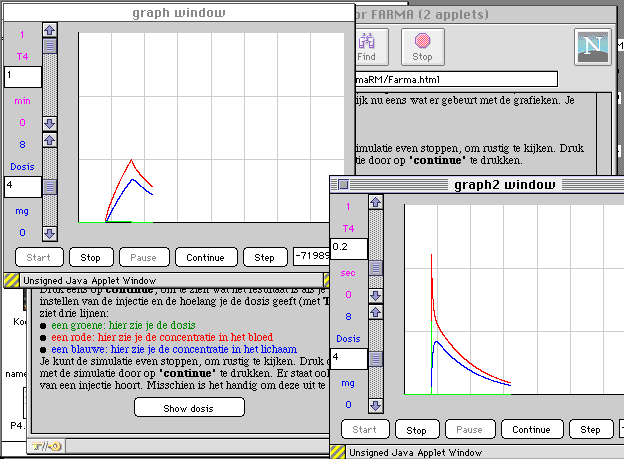
Figure 2. A screendump of the program FARMA; a simulator of the cardiovascular system. This is an in different educational situations very proofed simulation program, based on a small mathematical model. In the left corner you see an applet with an infuse situation and in de right corner the situation for injection the same dose as in the other situation. (See Min, 1997)
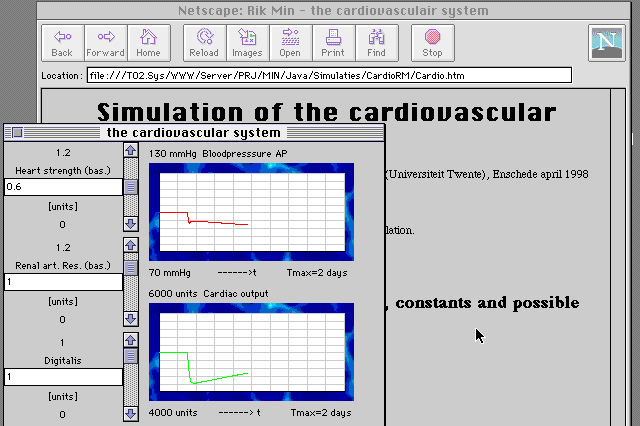
Figure 3. A screendump of the program 'CARDIO'; a simulator of the cardiovascular system. This is an old, and in different educational situations very proofed simulation program, based on a middle large mathematical model. (javaTHESIS version) (See Min, 1998)
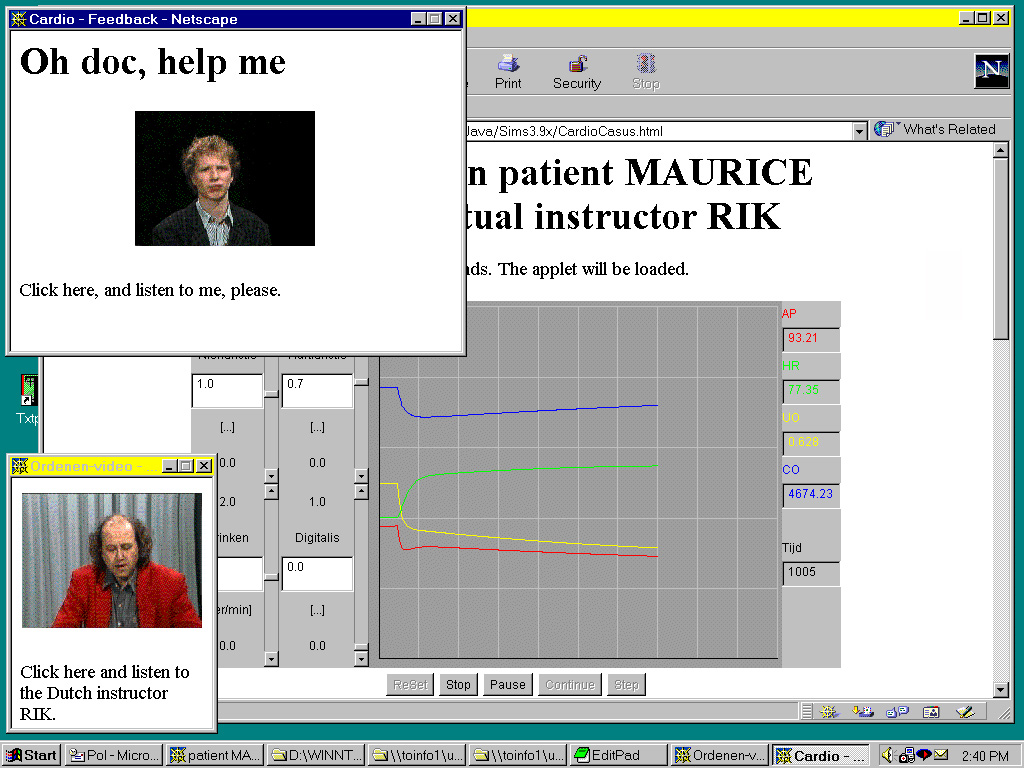
Figure 3b. A screendump of the program 'CARDIO' (the case 'Maurice'). An example of a full multimedia web-based learning environment (built accoording the PI theory). This screendump is an example of a simulation with a lot of 'parallel instruction': (1) an parallel instructor (left), (2) in the middle, the simulator and (3) above, the intelligent feedback (the patient, an other fragment from the video fragment database) (right) (Min & De Goeijen, 2000).
Other teaching materials
The WEB-site in which are applets are included contains all kinds of instructions and assignments. We consider this combination of our interactive dynamic simulation programs and our more or less static texts suitable for many types of education: vocational (MBO), secondary (VWO), higher vocational (HBO) and scientific level (WO). For the present there are only simulations based on small models. Only a limited amount of instruction is available and a limited number of tests. It is a prototype site. Students are now engaged in testing larger models on the WEB with our method and our system and they are also reorganizing the site.
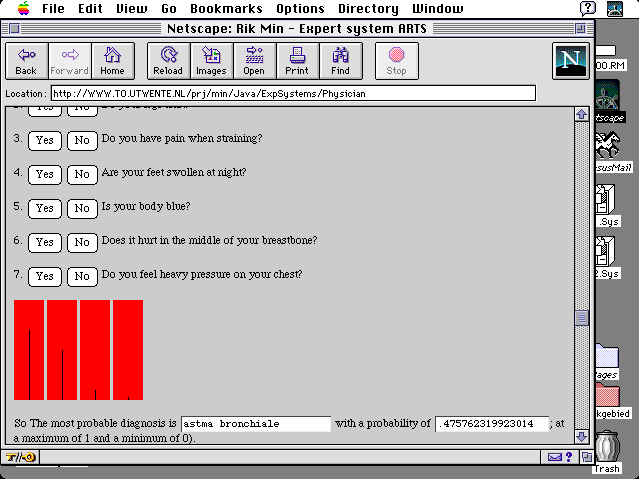
Figure 4. A screendump of the program ARTS; an expert system. This is writen in javaScript and it used 4 output objects writen in Java. (See Min, 19xxx)
After a simulation session the teacher can give the student a test via the WEB. In this scope we tested three types of on-line try-outs: two different kinds of tests with multiple choice questions and a test with open questions.
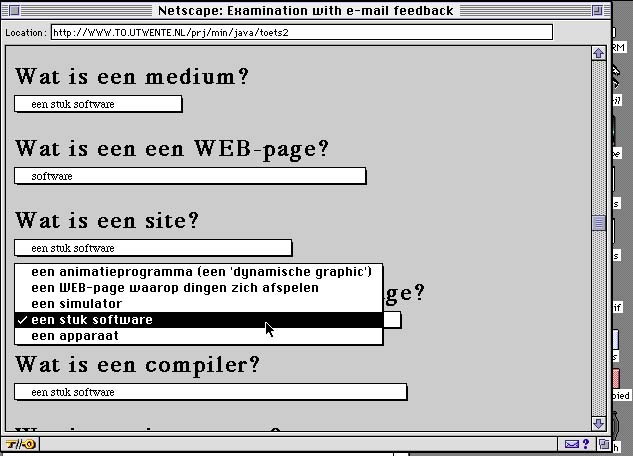
Figure 5. A screendump of the examination web-site. This test is writen in javaScript.
The test results are mailed directly to the teacher. The location of the relative WEB-pages is stated under the references.
Simulation system
Our investigations have indeed led to a prototype of a simulation system for the WEB: JavaTHESIS. The products which this system can supply are platform independent and therefore they can be run on any computer. With the help of this system models from biology, physics, economics and chemistry can be brought to life on the WEB.
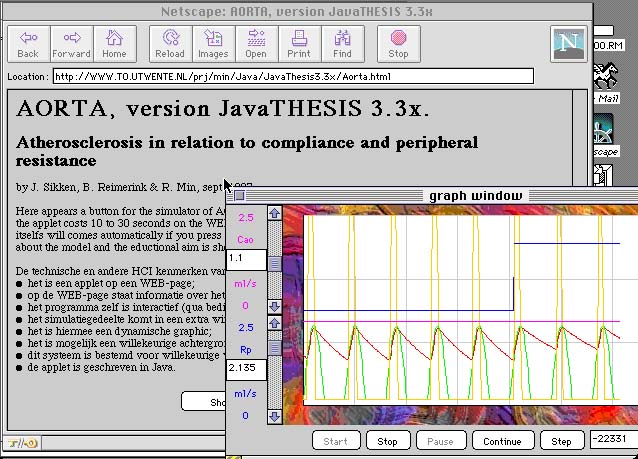
Figure 6. The learning environment on the WEB. The applet is called AORTA . The simulator was designed and developed with javaTHESIS; the WEB-pages themselves (with the 'instruction') are designed with WORD 6.0.
The pages containing the simulation programs have been tested on a Macintosh as well as on a Wintel platform. WEB-sites of schools or teachers can be completed or enlivened with this dynamic software or the dynamic graphics generated by this system.
Conclusions
Conclusions can be drawn on many points: the performance of applets and the system, spreading the software via the WEB, the advantages for teachers and we can be positive about the possibilities for multiwindow applications.
1. Applets are indeed very powerful. In spite of the fact that this type of software has to be interpreted by a browser, the performance as required for learning environments is fine. The performance of a simulation program as applet - embedded in all kinds of instruction material of a WEB-site - is fairly large but it is very much dependent on the dimensioning of the total embedding.
The simulator is not only quite fast with average-sized mathematical models, but the integration with the instruction materials in relation to other processes - such as those that play an important part in valuable learning environments for simulation - is satisfactory though this method.
2. The hypothesis that Java induces platform independence was confirmed. Our hypothesis that the WEB is a good medium for a teacher because he can adapt a learning environment (from somebody else) was partly confirmed. The assumption that many applications (such as WORD and WP) will soon be available in a WEB-page structure will probably be confirmed before long by the facts.
3. In respect of multiwindowing we have found that the WEB is indeed suitable. Many users and designers are not yet aware of all the possibilities of parallelism on the WEB. During the simulation session, the user can easily switch from one window to the other (partly overlapping) window. Manageability and speed of this construction appear sufficient at this point in view of our objectives. The three different testing programs all function on the WEB.
A multiwindowing version of a program has the advantage that a large information density can be achieved on a limited area of the screen. The effective look- and work-area of this form of dimensioning a learning environment becomes larger. The user is able to put the information he needs at that particular moment for a job side by side by manipulating two or three windows. For the users who are susceptible in this respect there are an additional degrees of freedom in working which are not available in a traditional working environment. Once a user has become accustomed with this type of working, more and more advantages will appear. See also Min and others (Min, 1994-1997).
4. In respect of spreading software we learned that the WEB is very suitable for the spreading of software, teaching materials and other things and ideas. Spreading through CD.ROM will probably continue for a while because extensive programs still cause too many problems due to the present capacity of the net. Down-loading programs via the WEB is quite easy and it is often done. That method of spreading is only practical however for software that is still platform-dependent.
5. The problem of interpreting by means of a browser continues to exist. However, java-applets have solved two problems: it is an easy and natural way of spreading software all over the world and a way to be platform independent.
6. The combination of simulation, instruction and testing on the WEB has proved very valuable together with a proper testing system. Further development work, testing of prototypes and evaluation of projects will have to establish what the power of this method and the WEB ultimately will be.
7. In the year 1997 the advantages outweigh the disadvantages of the supposed slowness of the WEB. Anyone can work with WEB-products after a little training and communicate with producers or teachers all over the world. That is very attractive for a designer, researcher or teacher. If you have a sound marketing plan you can conquer a large part of the market in one go.
Finally
The term Computer Based Training (CBT, CAI, CAL, COO) is entering its second lease of life in our point of view. But not in the limited sense of the classical term tutorial courseware or multimedia. No, in the widest sense of the word, viz. as computer based working- doing- and learning environments. For future education we need many open two-way-media and only a limited amount of one-way media.
References
Min, F.B.M. (1997)
Het WEB als werk-, doe- en leeromgeving en de kracht van applets. Paper ten behoeve van het congres: 'Studeren in digitale leeromgevingen'; Organiseren van hoger onderwijs voor de kennismaatschappij;. te Utrecht, op 11 en12 december 1997. Gepubliceerd in de Hoger Onderwijs Reeks van Wolters-Noordhoff Groningen. Titel: 'De Digitale Leeromgeving'. Ed. M. Mirande, J. Riemersma & W. Veen. 1997 ISBN 90-01-88662-0. Hst. 10. pp. 149-159.
Min, F.B.M. (1994) Parallelism in open learning
and working environments. Britsh Journal of Educational Technology;
Vol. 25, No. 2, pp. 108-112. ISSN 0007-1013.
Min, F.B.M. (1995) Simulation Technology
& Parallelism in Learning Environments; Methods, Concepts,
Models and Systems. Academic Book Center, De Lier. ISBN 90-5478-036-3
Min, F.B.M. (1996) Parallelism in working-,
learning- and doing-environments; The Parallel Instruction Theory
for Coaching in Open Learning Environments for Simulation; Proceedings
of EuroMedia 96; Telematics in a multimedia environment, dec.19-21,
1966; A publication of the Society for Computer Simulation International
(SCS) (Eds. A. Verbraeck & P. Geril)
Min, F.B.M. (1997) Locatie van de Java applets
op het WEB: WWW.TO.UTWENTE.NL/prj/min/Java/examples.html
simulatie homepagina






